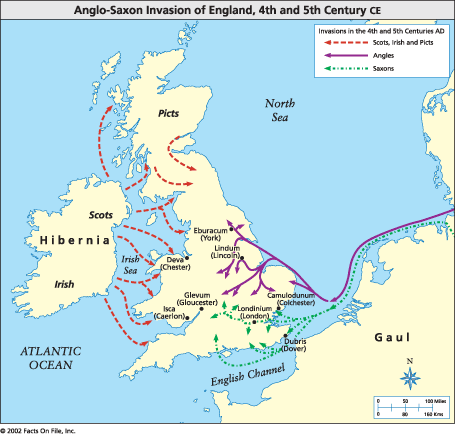The Angles and Saxons arrived in England sometime during the 5th century, not long after Rome had fled the island and left the Britons to fight against their northern aggressors, the Picts. According to the Anglo-Saxon Chronicle, in A.D. 449:
In their days Hengest and Horsa, invited by Wurtgern, king of the Britons to his assistance, landed in Britain in a place that is called Ipwinesfleet; first of all to support the Britons, but they afterwards fought against them. The king directed them to fight against the Picts; and they did so; and obtained the victory wheresoever they came. They then sent to the Angles, and desired them to send more assistance. They described the worthlessness of the Britons, and the richness of the land. They then sent them greater support. Then came the men from three powers of Germany; the Old Saxons, the Angles, and the Jutes. From the Jutes are descended the men of Kent, the Wightwarians (that is, the tribe that now dwelleth in the Isle of Wight), and that kindred in Wessex that men yet call the kindred of the Jutes. From the Old Saxons came the people of Essex and Sussex and Wessex. From Anglia, which has ever since remained waste between the Jutes and the Saxons, came the East Angles, the Middle Angles, the Mercians, and all of those north of the Humber.
The Britons had sent for help to these German tribes, and the Angles and Saxons obliged, but after having defeated the Picts, they did not return across the channel but stayed in southern England. They eventually turned on the Britons and drove them into western England, in what is today Wales. The name Wales is in fact Anglo-Saxon in origin, coming from the word “Walha,” which means foreigner or stranger.
The early Anglo-Saxon kingdoms, sometimes as many as seven and sometimes with more than one ruler, subjected their populations to fiscal and military obligations. The more powerful kings succeeded in establishing stronger and larger states, such as in Mercia, or in Wessex under King Alfred the Great (the only English king ever to be given the title of “Great”). These kingdoms lived in a somewhat peaceful state until the Viking invasions began in the 8th century. Viking aggression lasted until the 11th century, and during this time, England was in a constant state of warfare. The Danes conquered nearly all of Anglo-Saxon England, capturing the kingdoms of Northumbria, Mercia, and East Anglia. Only Wessex held out against the invaders, due in large part to the leadership of King Alfred.
Between 924 and 939, King Aethelstan of Wessex achieved some sort of unification in England, as did King Edgar from 959 to 975. From 1016 to 1035, the Scandinavian Canute sat the English throne, followed a few years later by the Anglo-Saxon Edward the Confessor. Harold Godwinson succeeded Edward after Edward’s death, but Duke William of Normandy challenged his succession and defeated Harold at the Battle of Hastings in 1066. Harold was the last Anglo-Saxon king to sit the English throne.
Despite the political turmoil and centuries of warfare that accompanied medieval Anglo-Saxon England, the Anglo-Saxons did make many cultural and economic contributions to the rest of Europe. They created substantial wealth through their various skills of craftsmanship, seen in their detailed metalwork, embroidery, stone and wood sculptures, and architecture. They also possessed great artistic talent in manuscript decoration and wall paintings, and they produced some 30,000 lines of poetry (much of it written in the common vernacular), including the most famous epic poem of Beowulf. Some of the most famous artistic works from the Anglo-Saxon medieval period include: jewelry from the Sutton Hoo excavation, the Franks Casket, the Ruthwell Cross, the Book of Durrow, the Lindisfarne Gospels, the Codex Amiatinus, the Vespasian Psalter, and certain churches such as Jarrow, Brixworth, and Bradord-on-Avon. Bede and Alcuin are probably the most well-known authors from that period.
Sources:
“Anglo-Saxon Chronicle.” Trans. James Ingram. London: 1847. Ancient and Medieval History Online. Facts On File, Inc. http://www.fofweb.com/activelink2.asp?ItemID=WE49&iPin=amdoc001&SingleRecord=True (accessed November 24, 2008).
English, Edward D. “Anglo-Saxons.” Encyclopedia of the Medieval World, vol. 1. New York: Facts On File, Inc., 2005. Ancient and Medieval History Online. Facts On File, Inc. http://www.fofweb.com/activelink2.asp?
ItemID=WE49&iPin=EMW0080&SingleRecord=True (accessed November 24, 2008).
*image retrieved from Facts on File, Inc.
Additional Reading:
F. M. Stenton, Anglo-Saxon England, 3d ed. (Oxford: Clarendon Press, 1971); James Campbell, ed., The Anglo-Saxons (Ithaca, N.Y.: Cornell University Press, 1982); Stephen Bassett, ed., The Origins of Anglo-Saxon Kingdoms (Leicester: Leicester University Press, 1989); H. M. Taylor and J. Taylor, Anglo-Saxon Architecture, 3 vols. (Cambridge: Cambridge University Press, 1965–1978); John Beckwith, Ivory Carvings in Early Medieval England (London: Harvey, Miller and Medcalf, 1972); J. J. G. Alexander, Insular Manuscripts 6th to the Ninth Century (London: H. Miller, 1978).

Excellent summation. Thanks.
You’re welcome, Scott. Glad you found it informative.